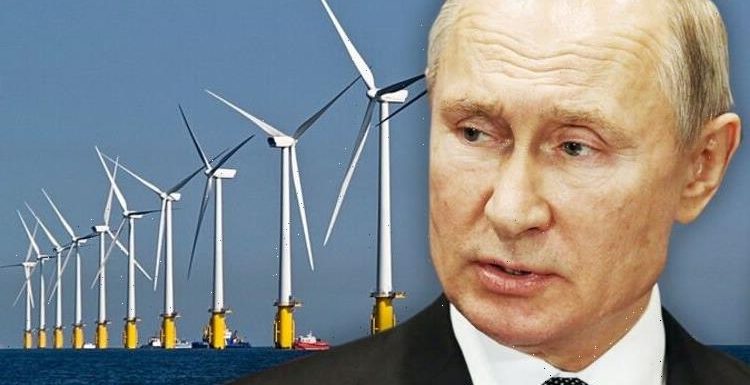
Wind farm technician explains how wind turbines work
We use your sign-up to provide content in ways you’ve consented to and to improve our understanding of you. This may include adverts from us and 3rd parties based on our understanding. You can unsubscribe at any time. More info
The payback predicted over the 18-month-period spanning October 2021–April 2023 are the results of wind farms’ contracted prices being lower than the current wholesale cost of electricity, which has been driven up by the present gas situation. The final saving could be larger, experts from the Energy and Climate Intelligence Unit (ECIU) said, as Vladimir Putin’s invasion of Ukraine is pushing gas prices up, prolonging the crisis. Furthermore, the researchers’ analysis has indicated that — as more turbines come online and increase in cost-effectiveness — wind could end up paying back up to £6.7 billion in a year in the event of another gas crisis in the near future. This, the researchers explained, is equivalent to an annual saving of £85 per UK household.
This figure could increase to the equivalent of £330 per home — or £26billion overall — should another crisis strike after 2030, by which point the UK will have exceeded its target of at least 40 gigawatts of offshore wind production.
While gas prices are expected to stay high for several years, most of the wind projects coming online at present would still offer payback even if the wholesale electricity price were to drop back down to 2021 prices of around £50 per megawatt-hour (MWh), the ECIU noted.
However, the circumstances of the current gas crisis mean that even the older — and, by extension, more expensive — wind projects are presently cheaper generators of electricity than gas-fired power plants.
The paybacks are coming by means of the UK Government’s Contract for Difference scheme, which provides a fixed price to renewables that have started operating since 2017.


In a policy paper, the Department for Business, Energy & Industrial Strategy explained: “Contracts for Difference incentivise investment in renewable energy by providing developers of projects with high upfront costs and long lifetimes with direct protection from volatile wholesale prices,
They added: “And they protect consumers from paying increased support costs when electricity prices are high.”
The scheme has been so successful, in fact, that the Government has now increased the frequency of Contract for Difference auctions to every year, rather than biennially.
According to the ECIU, the Contract for Difference “green levy” on bills has been set to effectively zero, meaning that customers will not be paying for the scheme’s wind farm contracts under the next price control.
In the future, they added, the Government might consider changing legislation such that the Contract for Difference levy could be made negative, allowing UK households to “essentially receive payments from cheap wind farms”.


Parliamentary Group on Renewable and Sustainable Energy chair Bim Afolami MP said: “Wind energy is cost-effective, clean and is providing an economic shot in the arm for everyone supplied with renewable energy to power their homes and businesses.
“We need to usher in more wind power capacity to keep prices low, and protect ourselves from volatile global gas prices and Russian gameplaying with our energy security.
“Through competitive auctions, the fixed price for electricity is locked in.
“The Contract for Difference scheme will enable investment to finance wind projects and all under our mission to decarbonise our energy supply to net zero.”
DON’T MISS:
‘US will enter war’- Putin sent dire warning over ‘next’ deadly move [REPORT]
Solar storm warning: Earth faces ‘triple threat’ from space as ‘direct impact’ predicted [ANALYSIS]
Energy crisis: PM handed ‘cake and eat it’ plan to CUT Russian ties [INSIGHT]

ECIU Head of Analysis Dr Simon Cran-McGreehin said: “Even though ‘green levies’ are falling and are dwarfed by the cost of gas on bills, there is valid debate as to whether these costs should be transferred to general taxation.
“It’s worth considering though this would mean any wind paybacks in future go to the Treasury and not potentially into people’s pockets.
“Scroll forward to more, even cheaper wind farms being built under the net zero target and there is a potential wind windfall of £26billion in a future gas crisis.”
This, Dr Cran-McGreehin added, would be “equivalent to shaving £330 off each home’s bills.”
Additional paybacks via the Contract for Difference scheme are expected in the coming few years as six major new offshore wind farms come online.
The first two will be the Moray East wind farm located off of north-east Scotland and Triton Knoll, which is being constructed offshore of the Lincolnshire coast.
According to the ECIU, Morary East, which is expected to come online by April this year, has the potential to pay back the equivalent of £6.50 per home annually during a gas crisis.
Triton Knoll, meanwhile, could pay back £5 per home per year during a future crisis after it comes online in the April of 2023.
The full findings of the study were published on the ECIU website.
Source: Read Full Article